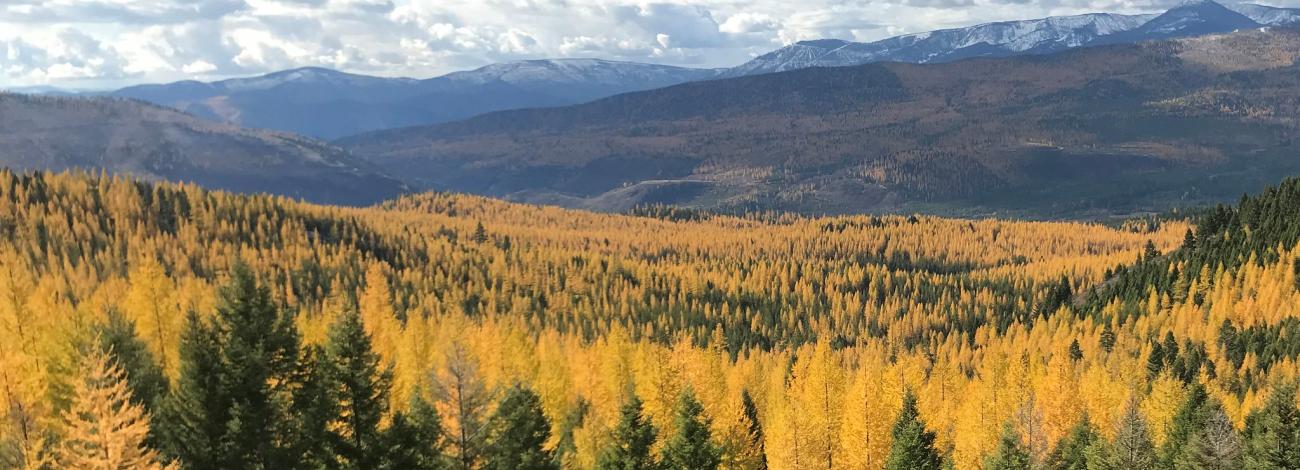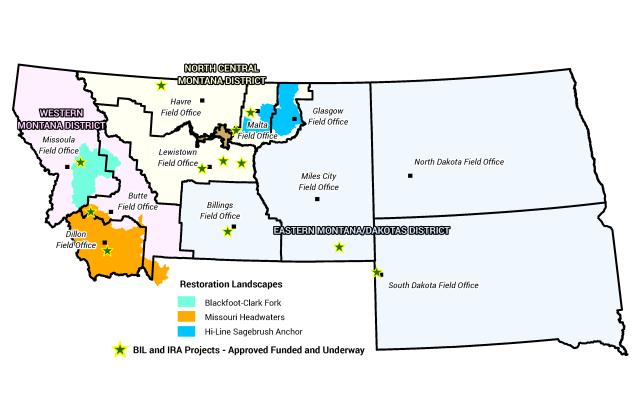
Restoring public lands across Montana, North Dakota and South Dakota
In 2023, the BLM identified 21 national restoration landscape areas to invest over $161 million of funding from the Inflation Reduction Act. This funding provides a once-in-a-generation opportunity to for transformational, durable ecosystem restoration that will significantly address climate change, sustainably protect sensitive ecosystems and support.
Funding from the Inflation Reduction Act will be directed to landscapes where concentrated, strategic investment through partnership can make the most difference for communities and public resources under the BLM’s management. In Montana, $27 million will be focused on three unique landscape areas, which will complement $8 million in funding from the Bipartisan Infrastructure Law. Within that pot of funding, $3.4 million will go to ecosystem restoration projects, while $5.57 million will go toward fuels work.
The BLM is invested in ensuring that our restoration landscapes provide a good return on investment to our local economies. We recognize that public lands play an immense role in economies in Montana, North Dakota and South Dakota.
Restoration Landscapes
- Missouri Headwaters Restoration Landscape
-
The Missouri Headwaters Restoration Landscape in southwestern Montana is set to receive $9.98 million of Inflation Reduction Act to support restoration objectives on 937,000 acres of BLM-managed lands.
Bridging two of the West’s iconic landscapes – the Greater Yellowstone and the Crown of the Continent – this area encompasses high-elevation mountain ranges, expansive sage-steppe and large, productive valleys that serve as a stronghold for wildlife that have disappeared from much of their historic range. This unique ecosystem is home to grizzly bear, westslope cutthroat, Arctic grayling, pronghorn, Greater sage-grouse and whitebark pine. Sagebrush grasslands anchor ecological systems and multi-generational family ranches intermixed with public land that supports vital recreational economies. Investments in restoration today will ensure these systems support people and wildlife alike into the future.
- Hi-Line Sagebrush Anchor Restoration Landscape
-
The Hi Line-Sagebrush Anchor Restoration Landscape commits $6.76 million of funding on 1.17 million acres of BLM-managed land.
Some of the largest intact grasslands left in North America support numerous at-risk grassland bird species, hold priority habitat for greater sage-grouse and provide critical winter and migration habitat for elk, deer and pronghorn. The short grass prairie of north central Montana is an extremely popular destination for hunting, fishing and bird watching. As drought continues, restoration investments will improve mesic and woody draw habitats; increase native plant diversity and remove encroaching conifers and human-made features that threaten sage-grouse survival. These restoration investments will advance the Department’s broader sage brush strategy, by building ecological resilience in core habitats and reducing the threat of wildland fire. - Blackfoot-Clark Fork Restoration Landscape
-
The Blackfoot-Clark Fork Restoration Landscape will utilize $9.54 million on 164,000 BLM-managed acres to work towards creating healthy forestland and wildlife habitat on the edge of one of the state’s largest cities, and ensure that the Blackfoot’s tributaries deliver clear, cold water to one of the state’s most beloved rivers.
Forest watersheds, lands with associated treaty rights and aboriginal connections, and places for outdoor recreation come together where these two storied rivers merge. Big game, grizzly bears, Canada lynx and bull trout habitat have all felt effects of former industrial logging and the growing pressures of climate change. Restoration here, in young to medium-age forests, will focus on decommissioning legacy roads and repairing perennial streams.FACT SHEET: Costewardship Highlights
FACT SHEET: Restoring Forest Health and Resiliency

